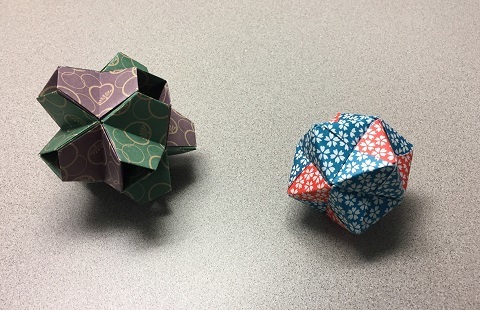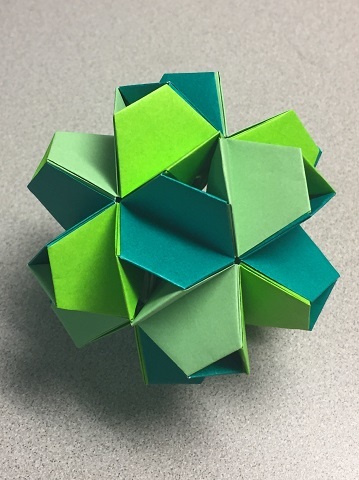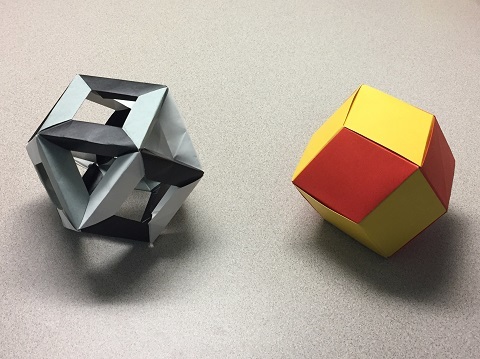Recent origami* has mostly been modular models, folded and assembled a couple units at a time during 5-minute breaks at work. This is partly for reasons of time, partly because the engineers I work with are appreciative, and partly because I'm working through dissatisfaction with my technique with animal models.**
Done while in the hospital for a kidney stone, because I couldn't do all cranes all the time:

Left: truncated stellated square antiprism (16*** Little Turtle units by Tomoko Fuse). Right: stellated octahedron (12 Sonobe units)
I especially like the unit used on the left, and used them again for a full icosahedron in greens:

Truncated stellated icosahedron (30 Little Turtle units)
This is not as stable as I'd like: it can be passed from hand to hand but grasped only gently. In general with modulars, there's a trade-off between ease of construction and stability: the easier all the tabs insert into all the slots, the easier they come out. (I keep thinking this ought to work as the vehicle for a powerful, flexible metaphor about life. I think that of a lot of origami -- see also footnote **.) If I spend the second half of assembly cussing under my breath, the result is solid.
And then there's this contrast between struts and solid faces, or maybe between monochrome and harlequins:

Left: cuboctahedron (24 unnamed units by Tomoko Fuse). Right: rhombic dodecahedron (12 units folded from A6 paper by Nick Robinson)
Fun times.
* Not counting disposable toys (paper airplanes, small animals) for TBD and/or friends.
** In particular, making them more expressive and less mechanical. So far, my answers are a) folding a little faster instead of sharply precise and b) trying to improve my detailing, especially heads. But if blocks were easy to work through, they wouldn't be blocks.
*** Because that was how many I'd folded when I was about to be discharged, so I found a polyhedron with that number of edges.
---L.
Subject quote from "Casino Royale" (1967).
Done while in the hospital for a kidney stone, because I couldn't do all cranes all the time:

Left: truncated stellated square antiprism (16*** Little Turtle units by Tomoko Fuse). Right: stellated octahedron (12 Sonobe units)
I especially like the unit used on the left, and used them again for a full icosahedron in greens:

Truncated stellated icosahedron (30 Little Turtle units)
This is not as stable as I'd like: it can be passed from hand to hand but grasped only gently. In general with modulars, there's a trade-off between ease of construction and stability: the easier all the tabs insert into all the slots, the easier they come out. (I keep thinking this ought to work as the vehicle for a powerful, flexible metaphor about life. I think that of a lot of origami -- see also footnote **.) If I spend the second half of assembly cussing under my breath, the result is solid.
And then there's this contrast between struts and solid faces, or maybe between monochrome and harlequins:

Left: cuboctahedron (24 unnamed units by Tomoko Fuse). Right: rhombic dodecahedron (12 units folded from A6 paper by Nick Robinson)
Fun times.
* Not counting disposable toys (paper airplanes, small animals) for TBD and/or friends.
** In particular, making them more expressive and less mechanical. So far, my answers are a) folding a little faster instead of sharply precise and b) trying to improve my detailing, especially heads. But if blocks were easy to work through, they wouldn't be blocks.
*** Because that was how many I'd folded when I was about to be discharged, so I found a polyhedron with that number of edges.
---L.
Subject quote from "Casino Royale" (1967).